How to Take Care of Your Musical Instruments in COVID-19 Crisis:
The Effects of Sanitizers to Yanagisawa Saxophones and the Other Instruments
As the COVID-19 infection is spreading widely, the importance of washing hands and sanitizing has been acknowledged which has made us use sanitizers and disinfectants more often in our daily lives.
Ministry of Health, Labour and Welfare, Ministry of Economy, Trade and Industry and Consumer Affairs Agency are providing a detailed guidance regarding the prevention against the virus, measures against the virus adhered to objects or in the air and caution against spraying sanitizer in a room based on the results of the tests done by the National Institute of Technology and Evaluation (NITE) in “The Effective Ways to Sanitize and Disinfect COVID-19”. (See the web-page below.)
“How to Sanitize and Disinfect COVID-19” (The dedicated website of Ministry of Health, Labour and Welfare, Ministry of Economy, Trade and Industry and Consumer Affairs Agency) *Japanese page only
https://www.mhlw.go.jp/stf/seisakunitsuite/bunya/syoudoku_00001.html
There are many people who are even more cautious with sanitizing when playing and taking care of their musical instruments. However, it is necessary to be careful when using such chemicals since some sanitizers (especially chlorine based sanitizers) have been confirmed to cause tarnishing, deterioration and damage to the instruments. Here, we have noted precautions based on the results of “Endurance test for lacquer finish against sanitizers” done by Yanagisawa Wind Instruments Co., Ltd.. Please read through the following and we hope that this will help you to keep your precious instruments in good condition.
When using sanitizers...
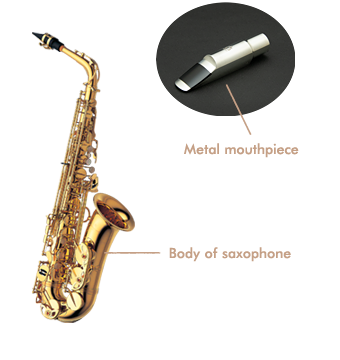
Immediately after that, use a dry cloth and wipe again completely.
Caution
DO NOT use chlorine based sanitizers for saxophones!
Do not use chlorine based sanitizers on your saxophones.
The components in chlorine based sanitizers could cause corrosion, deterioration and/or tarnishing of the metal and might also tarnish and loosen the lacquer.
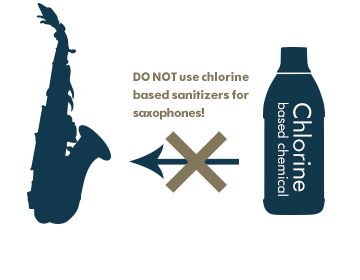
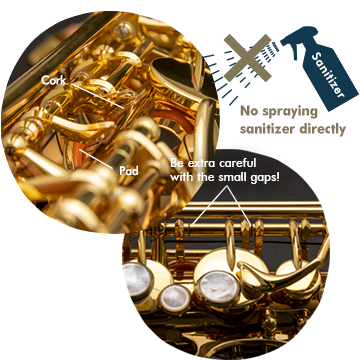
DO NOT adhere or spray the sanitizer directly, never soak in sanitizers!
Don’t adhere or spray the sanitizer directly onto instruments or keys. Also, don’t soak them in sanitizers.
If the chemical gets into the key system, it could damage the metal and disrupt the instrument function. Tampo or cork could get damaged too, if the chemical adheres to them.
Make sure your hands and fingers are dry after sanitizing before touching the instrument!
Make sure not to rub hard when wiping with a dry cloth!
When you sanitize your hands and fingers, make sure they are dry before touching the instrument.
If the sanitizer is still left on your hands and/or fingers, especially the parts where your fingers touch, such as thumb rest, thumb hook, and side keys could corrode and deteriorate. If the sanitizer adhered to the instrument, use a dry cloth and wipe but don’t rub too hard to avoid making scratches on the surface.
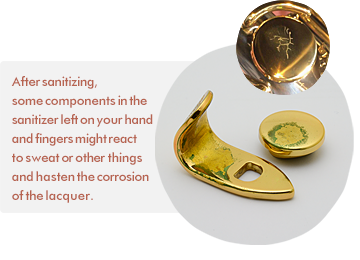
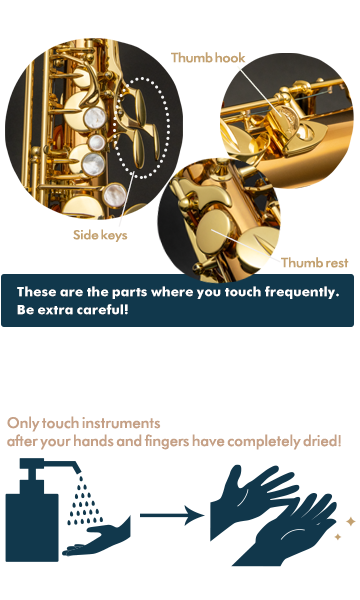
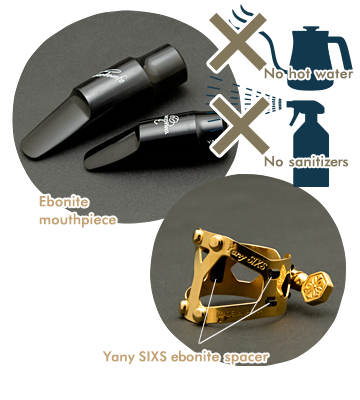
No chlorine based sanitizers and no heating for ebonite
Do not use chlorine based or ethanol based sanitizers for ebonite mouthpieces and Yany SIXS ligatures (The spacer part is made of ebonite). Also, do not try to disinfect by putting the instruments in boiling water or doing any kind of heating. It might cause tarnishing and/or deterioration.
When sanitizing an ebonite mouthpiece, wash gently using a neutral detergent in cold water and rinse completely under running water. (For more information, see the web-page “How to Sanitize and Disinfect COVID-19” *Japanese page only)
Be careful with cases, too!
You need to be careful sanitizing saxophone cases, too.
When you spray sanitizers inside the case, make sure that it’s dried completely before putting your instrument in it.
However, even it’s dry, some components in sanitizers might still be left. Depending on the component, the instrument could get damaged in such a sealed case.
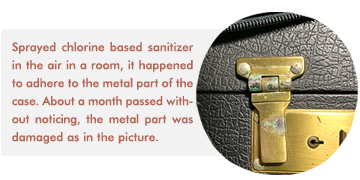

Endurance test for lacquer finish against sanitizers
Here is the summary of the “Endurance test for lacquer finish against sanitizers” done by Yanagisawa Wind Instruments Co., Ltd. (Done in October-November, 2020).
For the testing parts, they used new (at the level of ready-to-ship-from-factory condition) lacquer finished thumb hooks, thumb rests and neck screws (Intentionally damaged to see the effects through the scratches) soaked in 8 different sanitizers – and observed for approximately one month. The chart below is showing the changes caused by adherence of each chemical inspected in 5 levels.





| Chemicals | Ethanol (Alcohol based) |
Ethanol (Alcohol based) |
Ethanol (Alcohol based) |
|---|---|---|---|
| Components | Ethanol | Ethanol (including isopropanol) |
Ethanol Glycerin-fatty acid ester Glycine Sodium emulsified |
| Day 1 | - |
- |
Unclear misty color change 2mm around the screw hole. |
| Day 2 | - |
- |
Color changed to blue on the side of the thumb rest. The lacquer started to come off here and from the misty part of the screw hole area. |
| Day 3 | - |
- |
Bluish green verdigris-like rust appeared on the back side or the thumb rest. |
| After 1 week |
No reaction |
No reaction |
More damage on the lacquer. |
| After 1 month |
No reaction |
The surface of the thumb rest is getting rougher. |
The lacquer came off and the surface color changed to cobalt blue. |
| Results | 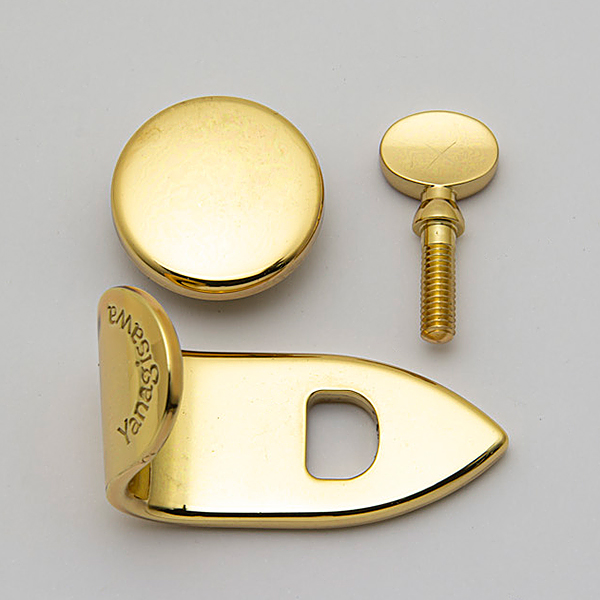  |
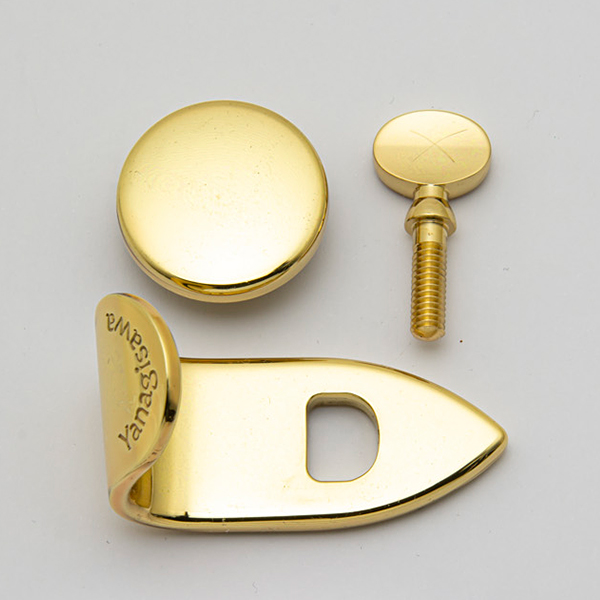  |
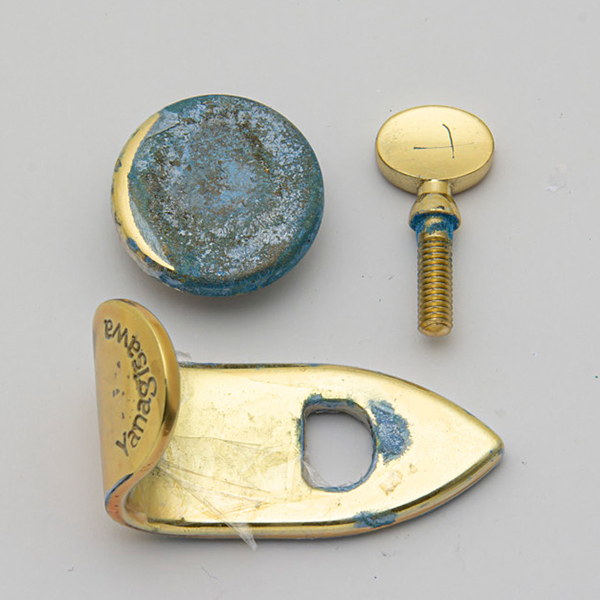  |
| Chemicals | Ethanol (Alcohol based) |
Ethanol (Alcohol based) |
|---|---|---|
| Components | Ethanol Glycerin Schizophyllan |
Benzalkonium chloride Ethanol Glycerin |
| Day 1 | - |
- |
| Day 2 | No reaction |
- |
| Day 3 | - |
- |
| After 1 week |
- |
No reaction |
| After 1 month |
The sanitizer changed from gel to light liquid. The liquid color changed to light blue. Bluish green verdigris appeared around the bottom of the screw top. |
Light damage can be seen near the hole of the thumb hook screw. |
| Results | 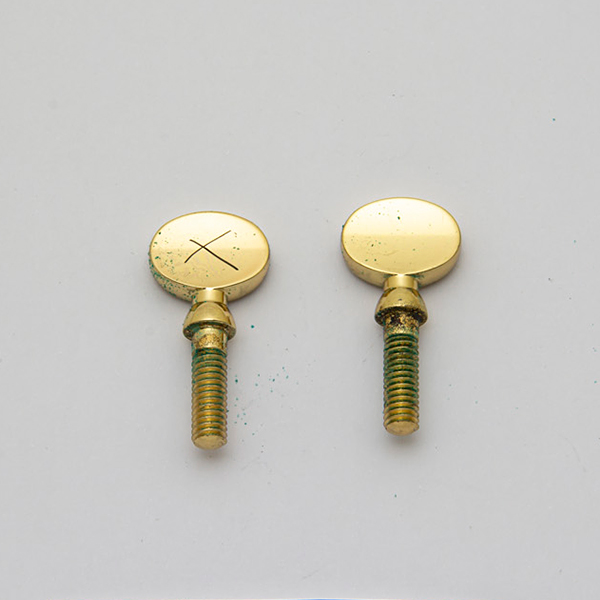  |
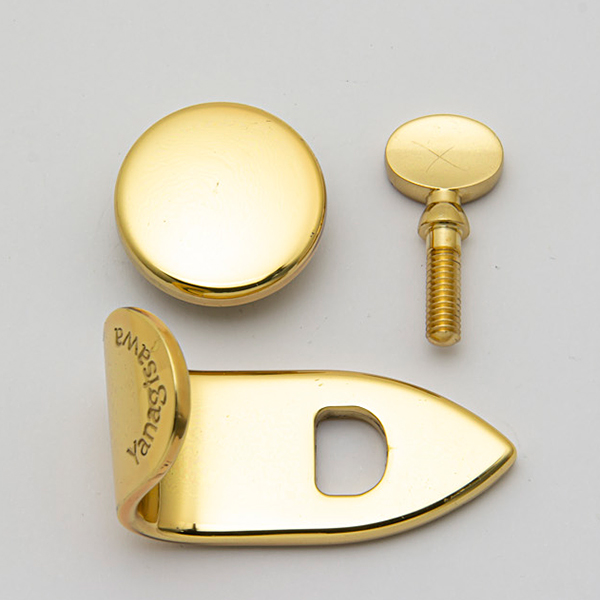  |
| Chemicals | Sodium hypochlorite solution(Chlorine based) |
Chlorine dioxide solution(Chlorine based) |
Carboxylic acid based |
|---|---|---|---|
| Components | Sodium hypochlorite (chlorine based) Sodium hydroxide (alkaline agent) Alkyi ether sulfate sodium (surfactant) *Diluted to 0.05% |
Chlorine dioxide | Carboxylic acid based organic matter (food addictive complex) as a principle component Sodium citrate |
| DAY 1 | - |
The surface of the lacquer finish became rough and partly reddish. |
- |
| DAY 2 | No reaction |
- |
- |
| DAY 3 | - |
- |
- |
| After 1 week |
- |
- |
White misty color appeared around the 6th day. |
| After 1 month |
White misty corrosion appeared on the lacquered surface of the thumb rest after around 3 weeks. |
More damage spreading widely on the lacquered surface. |
The lacquer corrosion was found from the misty color area. |
| Results | 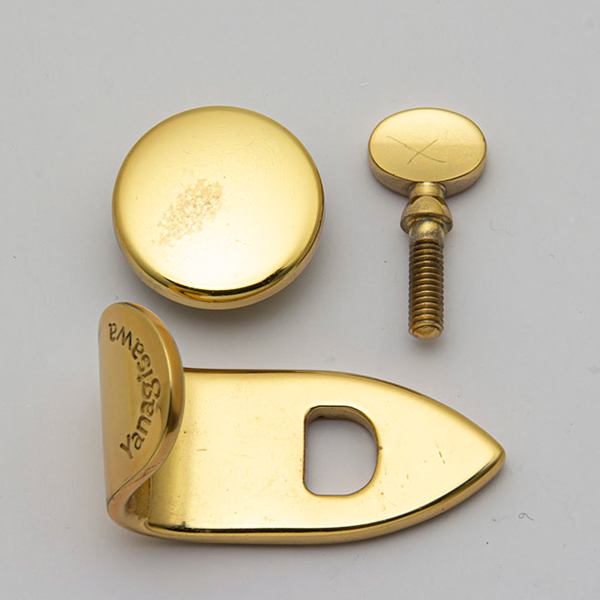  |
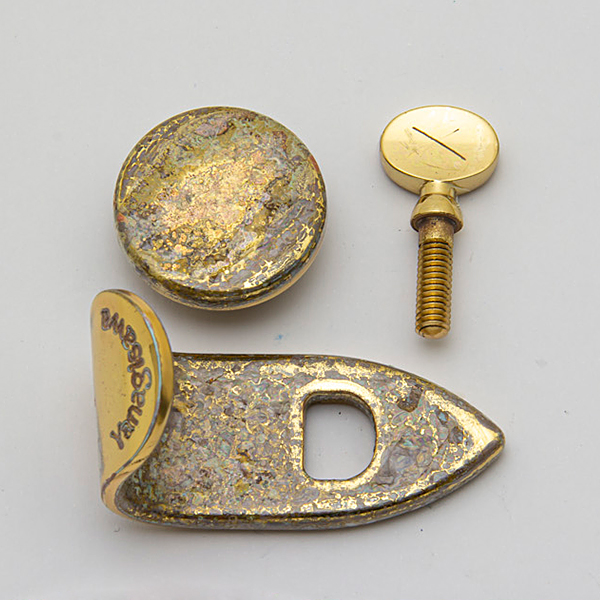  |
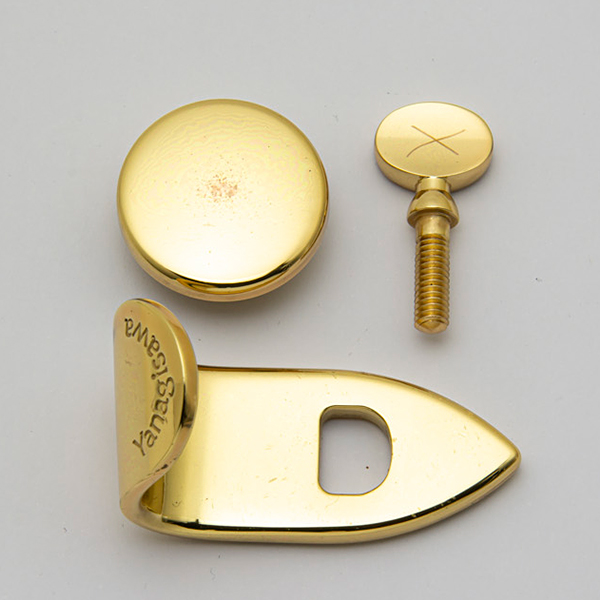  |
From this test, there was almost no change by 100% ethanol, but even though the main component is ethanol, depending on the other contained chemicals, the conditions of Level 1-3 appeared approximately after 1 month. (Some showed a major Level 5 damage.) On the other hand, most of the chlorine based chemicals caused remarkable tarnishing in the result. For example, sodium hypochlorite solution (chlorine bleach) showed Level 3 condition after 3 weeks, and chlorine dioxide solution showed Level 5 from the first day. However, since the content rate and/or components in sanitizers differ depending on manufacturers to a certain degree, these results are not showing everything. Please take it as a guideline.
Review: When you use sanitizers to take care of your instruments...

Immediately after that, use a dry cloth and wipe again completely.
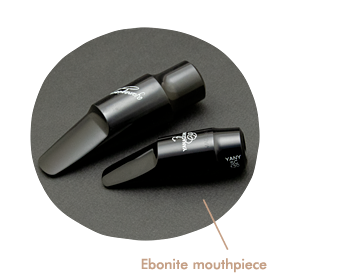
In addition, the maintenance methods introduced on this page is for new products (at the level of ready-to-ship-from-factory condition). The effects might change depending on the original condition of each instruments. Please take this information as a guideline and find the best way that matches to your own instruments.
Also, it is important to practice hand-washing, gargling and other things you can do as a daily routine to keep yourself healthy. Wash your hands and gargle before playing instruments, wash the swabs and cloth more frequently, too, and always keep them clean.
We hope that you and your instruments stay in healthy condition and hope you enjoy playing them for many years.
